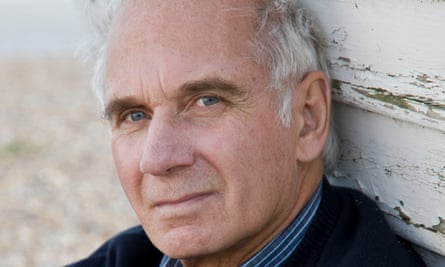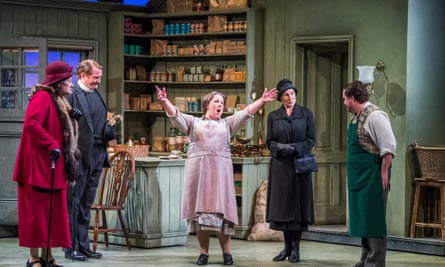Though most closely associated with the works of Benjamin Britten, the conductor Steuart Bedford, who has died aged 81 after complications from Parkinson’s disease, was able to turn his professionalism and interpretative talents to great advantage in a range of other repertory too. The operas of Mozart elicited from him an authoritative response over a number of years at Garsington Opera while it was based in Oxfordshire.
Having launched his professional career with The Beggar’s Opera at Sadler’s Wells theatre in 1967, he went on to conduct his own edition of Monteverdi’s L’Incoronazione di Poppea at the Royal Academy of Music (1969), following that with the first modern British performances of Donizetti’s Belisario, also at the RAM (1972). During the years of Britten’s final illness in the early 1970s, Bedford came to the fore as a reliable and insightful interpreter of his works. Having already assisted on the 1966 Decca recording of A Midsummer Night’s Dream, he was asked in 1970 to take over rehearsals for the filming of the TV opera Owen Wingrave while the composer recovered from a hernia operation.
In 1973 he was put in charge of the preparations and world premiere of Death in Venice at the Aldeburgh festival in Suffolk. He also took both Owen Wingrave and Death in Venice to Covent Garden (1973), conducting the latter many times at home and abroad. His recording of Death in Venice, with Peter Pears, John Shirley-Quirk and James Bowman in the roles they created, was made at Snape the year after the premiere.

As Britten’s trusted “heir apparent”, as Bowman described him, Bedford was the natural choice for the job. He went on to record many of Britten’s works, often for Collins Classics, but also for EMI, Decca and Chandos.
When Britten decided in the last years of his life to revise his early opera Paul Bunyan, suppressed after the adverse reaction to its New York premiere in 1941, it was again Bedford who was entrusted with both its first European performance, on radio in a Manchester studio production, and its first British stage performance (1976). So successful was he in capturing the edgy youthful vigour of the work that many expressed surprise that the composer had withheld it so long.
No less successful was the premiere the same year of the dramatic cantata Phaedra, which he conducted at Aldeburgh with Janet Baker in the title role, achieving considerable intensity despite the spare textures.
He was appointed musical director of the English Opera Group in 1971 and in 1975 joint artistic director (with Colin Graham) of the English Music Theatre Company into which the group expanded. He was an artistic director of the Aldeburgh festival from 1974 to 1998, and presided over the triumph of Tim Albery’s production of Peter Grimes on Aldeburgh beach in 2013, in celebration of the composer’s centenary.
Bedford was perhaps destined for music through both sides of his parentage. His father, Leslie Bedford, the director of engineering for the guided weapons division of the British Aircraft Corporation, was the son of the soprano and composer Liza Lehmann. She and Maude Valérie White were the foremost female composers of songs at the turn of the 20th century and Lehmann was the first president of the Society of Women Musicians.
His mother, Lesley Duff, was also a singer, and worked with the English Opera Group in the late 40s – she was the first Emmie (one of the village children) in Albert Herring and sang Lucia in The Rape of Lucretia. It was her purchase of a cottage at Snape, at the period of her engagement by the company, that brought her son into initial social contact with Britten. Mother and son visited Britten and Pears frequently, “getting involved in parties and games and cricket matches and things”, as Bedford later recalled.
It was with Albert Herring that he made his debut as a conductor, while organ scholar of Worcester College, Oxford, at the Playhouse in that city (1964), an experience that decided him in favour of conducting as a career rather than that of a cathedral organist. He did nevertheless perform with distinction as a concert pianist on a number of occasions, undertaking the Second and Third Concertos by Rachmaninov, among others.

In 1965–66 he was a member of the Glyndebourne music staff, joining the English Opera Group in 1967, with whom he made his professional debut. At this time he was also a professor at the Royal Academy of Music and conductor of the opera class. He conducted the premiere of John Gardner’s chamber opera The Visitors at the 1972 Aldeburgh festival, by which time he had won the respect of Britten as a reliable collaborator.
The Mozart connection with Garsington Opera began with Le Nozze di Figaro in 1993 (which he shared with Stephen Barlow) and developed in subsequent years with a series of productions from Così fan Tutte (1997, 2004, 2008), Die Zauberflöte (2001) and Don Giovanni (2002) to Lucio Silla (1998), La Finta Giardiniera (2003) and Il Re Pastore (2007). Such was their success that Glyndebourne was advised to look to its laurels as the keeper of the Mozartian flame, at least in terms of country house opera companies. Other non-Britten conducting projects included Madam Butterfly at ENO (1981) and the first performances of Lowell Liebermann’s opera The Picture of Dorian Gray (Monte Carlo, 1996, and its US premiere, Milwaukee, 1999).
In 2015 he returned to Garsington Opera, now based in Buckinghamshire, with Death in Venice, and his last professional engagement was Albert Herring at the Grange festival, Hampshire, in 2017, following which retirement was forced on him by the onset of Parkinson’s disease.
Remembered by many as a generous, supportive colleague, he was married to the soprano Norma Burrowes from 1969 until they divorced in 1980. His second wife, Celia Harding, predeceased him in April last year. His brother, the composer David Bedford, died in 2011. A third brother, Peter Lehmann Bedford, who sang with the Glyndebourne Festival Chorus, died in 2004.
He is survived by his two daughters, Charmian, a soprano, and Joanna, education manager of Opera North, and two grandchildren, Alun and Emile.
